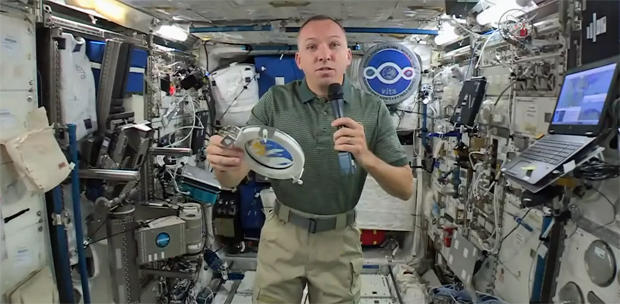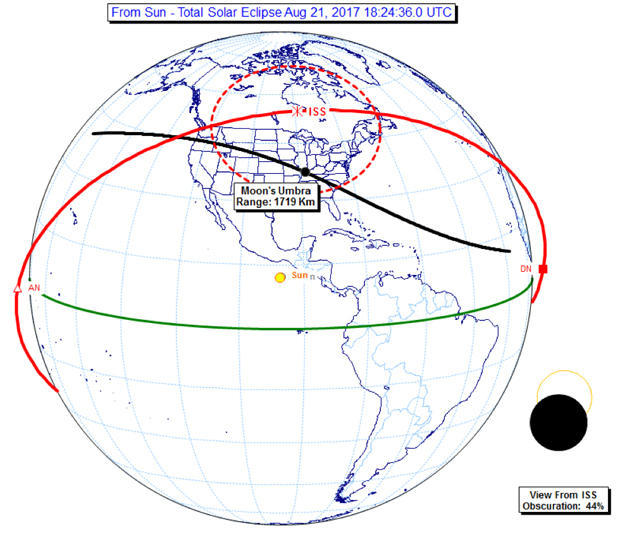Space station crew to get three shots at solar eclipseCBS News
By/ William Harwood / August 11, 2017, 4:38 PM
The International Space Station's crew will enjoy views of the Aug. 21 solar eclipse during three successive orbits, giving the astronauts a unique opportunity to take in the celestial show from 250 miles up as the moon's shadow races across from the Pacific Ocean and the continental United States before moving out over the Atlantic.
"Because we're going around the Earth every 90 minutes, about the time it takes the sun to cross the U.S., we'll get to see it three times," Randy Bresnik said Friday during a NASA Facebook session. "The first time will be just off the West Coast, we'll actually cross the path of the sun, and we'll have (a partial) eclipse looking up from the space station."
For the station crew, the first partial eclipse opportunity will begin at 12:33 a.m. EDT (GMT-4) and end 13 minutes later.
Floating in the European Columbus laboratory module, Bresnik showed off a solar filter shipped up to the station earlier, saying "we've got specially equipped cameras that'll have these solar filters on them that allow us to take pictures of the sun. That's going to be pretty neat, we'll have a couple of us shooting that."
 Space station astronaut Randy Bresnik shows off a solar filter that will be used by the crew during multiple opportunities to photograph the Aug. 21 solar eclipse from their perch 250 miles up. / NASA TV
Space station astronaut Randy Bresnik shows off a solar filter that will be used by the crew during multiple opportunities to photograph the Aug. 21 solar eclipse from their perch 250 miles up. / NASA TVOne orbit later, the station will cross the path of the eclipse in the extreme northwest following a trajectory that will carry the lab over central Canada on the way to the North Atlantic. From the station's perspective, 44 percent of the sun will be blocked in a partial eclipse. But the crew will be able to see the umbra, where the eclipse is total, near the southern horizon.
"We'll be north of Lake Huron in Canada when we'll be able to see the umbra, or the shadow of the eclipse, actually on the Earth, right around the Tennessee-Kentucky (area), the western side of both those states," Bresnik said. "That'll be an opportunity for us to take video, and take still pictures and kind of show you from the human perspective what that's going to look like."
 During the second of three successive orbits, the space station crew, passing just south of Hudson Bay, will have a chance to see and photograph the moon's shadow as it moves across western Kentucky and northwestern Tennessee some 1,100 miles away. / NASA
During the second of three successive orbits, the space station crew, passing just south of Hudson Bay, will have a chance to see and photograph the moon's shadow as it moves across western Kentucky and northwestern Tennessee some 1,100 miles away. / NASA The umbra, defining the 70-mile-wide shadow where the sun's disk will be completely blocked out, will be at its closest to the space station at 2:23 p.m. The moon's shadow will be about 1,100 miles away from the lab complex, but from their perch 250 miles up, the astronauts should be able to photograph the dark patch as they race along in their orbit.
"And then the third pass is actually just off the East Coast," Bresnik said. "We'll come around one more time and from the station side we'll see about an 85 percent eclipse of the sun looking up (at 4:17 p.m.). So we should be able to get really neat photos, with our filters, of the sun being occluded by the moon."
NASA plans to provide four hours of eclipse coverage, starting at noon EDT, on the agency's satellite television channel, in web streams and via social media, including Twitter, Instagram and Facebook.
"We have a lot of options to share all this," Bresnik told a Facebook questioner. "It's U.S. taxpayer dollars. ... You're paying us to take these pictures, and they go to you. They're free to everybody, and you can access them from the NASA website."
.
© 2017 CBS Interactive Inc. All Rights Reserved.http://www.cbsnews.com/news/solar-eclipse-august-21-2017-space-station-crew-gets-three-shots/?ftag=YHF4eb9d17&yptr=yahoo





















 Select your theme
Select your theme
